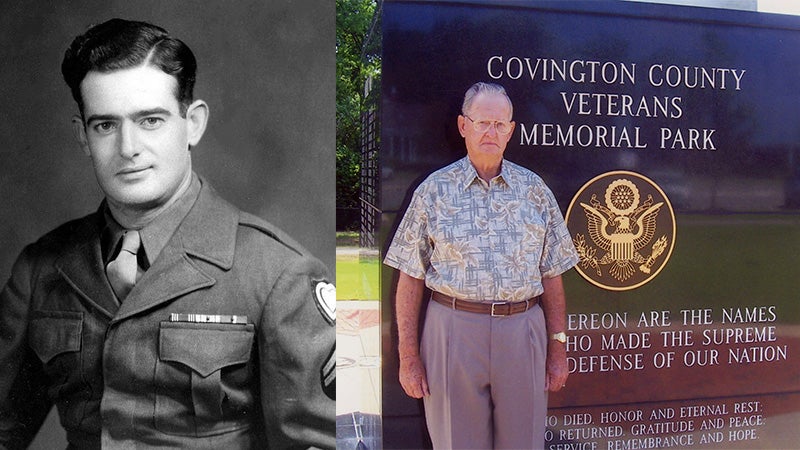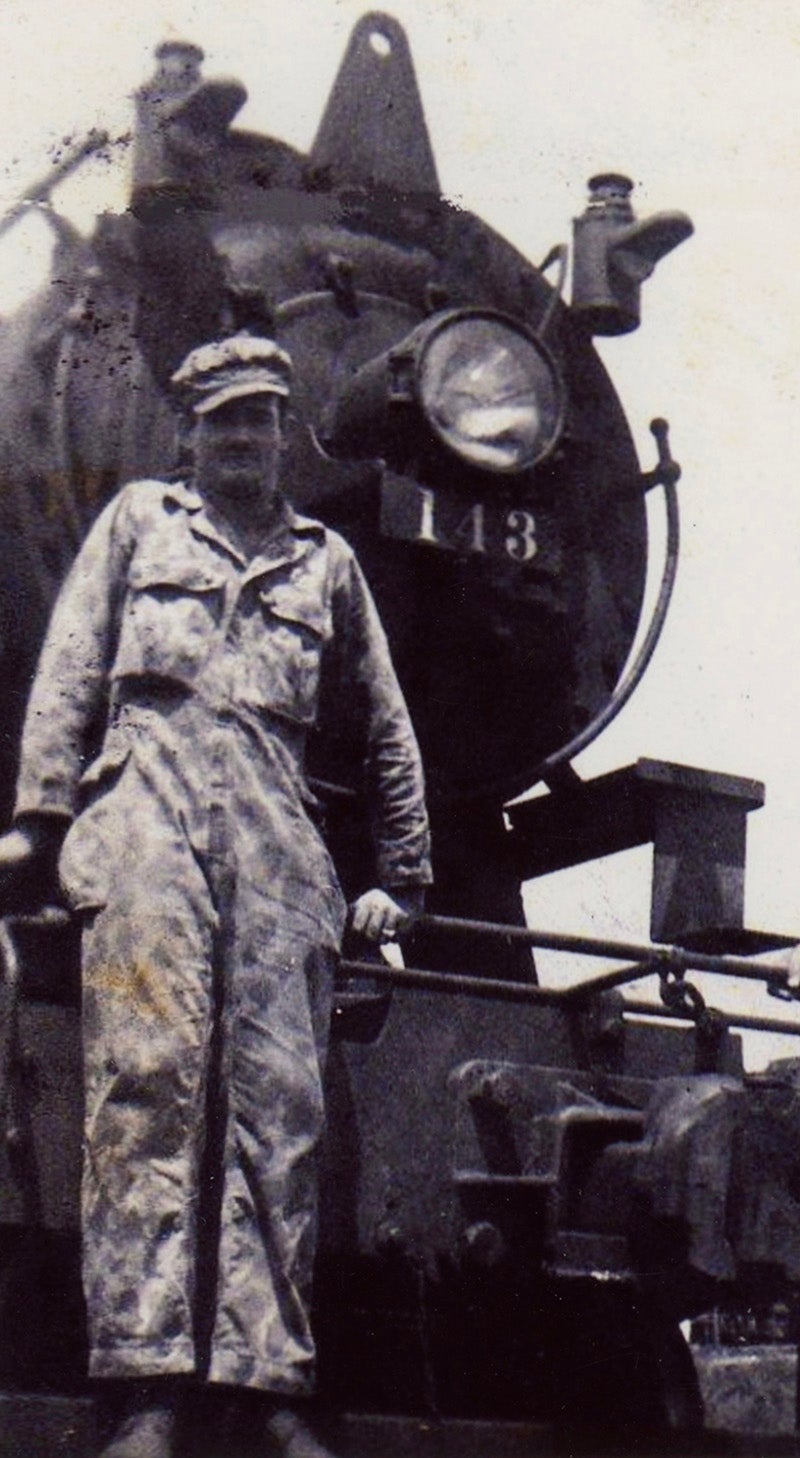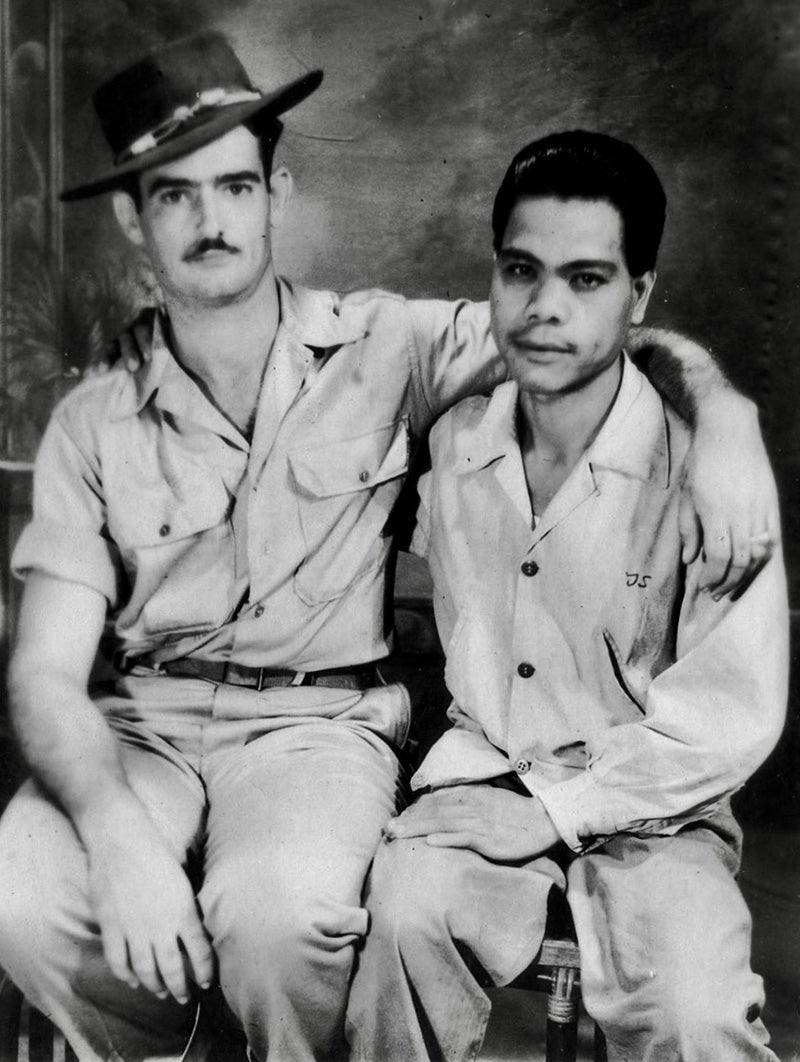Morgan W. Colquett, Tech4/Sergeant, U.S. Army, WWII
Published 1:29 pm Friday, July 28, 2023

- LEFT: Tech4/Sgt. Morgan W. Colquett in wartime photo taken after the Liberation of the Philippines. RIGHT: Morgan Colquett standing beside the Covington Veterans Memorial in Andalusia, Alabama, 2006. Photos courtesy of Angela Colquett Nelson
|
Getting your Trinity Audio player ready...
|
Morgan Colquett’s ship arrived at Manila harbor in the middle of the night. To protect against Japanese bombers, all lights were out and he could see nothing. Off in the distance, he heard a siren and wondered if they were under attack.
The next morning, he found out that the Japanese had attacked a neighboring town. After nearly 30 days at sea, he was anxious to see the harbor in daylight. To his amazement, there were sunken ships all around, their rusting masts protruding above the water. He learned later that more than 280 ships had been sunk in the harbor.
Morgan Willis Colquett was born in Opp, Alabama, on November 28, 1921. His parents were Joe Colquett and Beulah Willis Colquett. They would have four children including Morgan, a son, David, and two daughters, Annie Jo and Eloise.
Morgan attended Fleeta School through the 8th grade, then transferred to Opp High School. He graduated in 1940, a year late because he had to drop out a year when his dad became severely ill. Before enlisting in the Army, Morgan worked on the family farm, at the Opp cotton mill and at the Opp ice plant.
On March 13, 1944, Morgan enlisted in the Army at Fort McPherson, Georgia. He was sent to Camp Leroy Johnson near New Orleans, Louisiana, for basic training. After that, he was assigned to Fort Claiborne, Louisiana, for 13 weeks of technical training as a fireman on a locomotive.

Morgan Colquett standing by his locomotive on the island of Luzon in the Philippines, August 1, 1945. [Photo: Angela Colquett Nelson]
Morgan’s battalion embarked aboard a converted Norwegian transport that had no ventilation. During the long voyage, the troops slept topside. They left the U.S. in February and made a stop in New Guinea on March 8. They were happy when they finally arrived at the port of Manila on March 26. Unfortunately, Manila was hot with temperatures reaching 100 degrees. They had to sleep under mosquito nets.
When Morgan and the 737th ROB arrived, Manila had only been liberated for a month and there were still small bands of Japanese soldiers in the countryside. His first duty was Sergeant of the Guard and he carried a sub-machine gun. He recalled that the Philippine people were starving because of the harsh treatment by the Japanese during occupation. No dogs or cats could be seen as most of them had been killed and eaten. The Philippine water buffalo, called a carabao, was plentiful but was not often used for food because it was needed as a “beast of burden.” The carabao is considered a national symbol of the Philippines.
After a few weeks, the 737th ROB was relocated to Tarlac City, about 65 miles north of Manila. The city of Bamban was about half way to Tarlac City. Both cities were main distribution points for Allied supplies for the Philippines. The trains that ran between Manila, Bamban and Tarlac City, usually ran at night without lights because of the occasional attack by Japanese guerillas.
Morgan became a telegraph operator on the trains at Bamban. He also worked at the train depot at Bamban, which was without a roof that had been blown away by the Japanese. He worked 12-hour shifts, seven days a week, for six weeks, then had a day off. His job was to monitor train traffic and give clearances for train movement. The job was made more difficult because the trains operated at night, without lights.
At Bamban, Morgan met a young Filipino named Juan. He performed chores and upkeep around the tents for the battalion. Juan had an interesting story. He had been captured by the Japanese when they invaded the Philippines in 1941. Juan and a group of Filipino prisoners had been scheduled for execution but Juan had managed to escape the day before and free the others.
Morgan remembered that Juan was a good worker and brought them bananas and coconuts, as well as fresh water. He also brought a five-gallon water can filled with a native whiskey that he called Panoke.
Near the end of the war, Morgan and the 737th ROB were made a part of the U.S. 6th Army and sent to a staging area on the beaches of the Lingayen Gulf. The Army’s various fighting units were being staged for the invasion of Japan. Morgan recalled that they had just gotten settled in and gotten their tents put up when a typhoon hit.
Morgan described the scene after the typhoon. He said he saw tents in the palm trees and footlockers floating on the flooded beaches. While his battalion was still awaiting orders and cleaning up after the typhoon, Morgan and a friend took a short trip to the nearby resort town of Baguio [also called Little Birmingham].

Morgan Colquett with his friend, Juan, who helped Colquett’s battalion as a tent boy. He cleaned their tents and living area and also brought fresh fruits and water.
[Photo: Angela Colquett Nelson]
After they arrived at Baguio, they were met with many prisoners who had just been released from a Japanese prison camp. The Red Cross was tending to the sick and starving prisoners. Many of the prisoners greeted Morgan and his friend with hugs and tears.
Morgan returned to the camp, awaiting orders when he learned the good news that Japan had officially surrendered on September 2. He and the 737th ROB departed for Korea in October 1945. The unit was sent to Seoul after landing at Pusan harbor. They stayed at the Emperor’s summer home at Finchon. Morgan and his unit would remain in Korea until March 1946, when they boarded the ship, Marine Devil, for their return to the States.
Their voyage was interrupted by massive tidal waves created when an earthquake struck in the Aleutian Islands off the coast of Alaska on April 1. The men were sick for days because of the tsunami. Bad luck seemed to follow them as an outbreak of smallpox hit the ship about the time they docked in San Francisco. The disease killed 21 men aboard the ship.
After being quarantined for 21 days, Morgan and the other men were released. He was discharged on April 15, 1946. He had been awarded the Philippine Liberation Medal with Bronze Star, the World War II Victory Medal, the Asiatic-Pacific Campaign Medal and the Good Conduct Medal.
Morgan said that Opp, Alabama, had never looked so good when he arrived home. He soon met Myrtice Davis from Headland, Alabama, who was employed at the Alabama Textile Corporation [Alatex], in Andalusia. They were married in 1948 and settled down in Opp, Alabama. They had three children, Joey, Kent and Angela.
Morgan began work at Ralph Avant’s Oil Distributing Company after returning home. He was a route salesman delivering gasoline to service stations throughout south Alabama and northwest Florida. After starting at the bottom, Morgan worked his way to the top and purchased the company in 1969. He named the company, Colquett Oil, and through the years was a distributor for Pure Oil Company, Union 76 and Fina. At one time, he delivered gasoline to 32 service stations.
Morgan Colquett was a devout Baptist. He joined the Sweetwater Baptist Church in Fleeta as a young boy and later, he and his wife joined the First Baptist Church of Opp after they were married. He was active in the church as a deacon and a teacher. He was also a member of the Opp Civitan Club. During holidays, Morgan could be seen early in the morning, in downtown Opp, putting up “Old Glory,” in fronts of buildings, and then taking them down late in the afternoon.
Morgan was never bored. He loved growing vegetables and giving them to family and friends. He enjoyed refurbishing tractors and old farm equipment, then selling them.
In 2008, Morgan participated in a Birmingham, Alabama, program that interviewed veterans. He recorded several hours of interviews which were condensed to a 30-minute DVD and copies were given to his family.
Morgan Colquett died on August 23, 2010, in Opp. His funeral was held at the Wyatt Funeral Home Chapel and he was buried with military honors at Peaceful Acres Cemetery in Opp. He was preceded in death by his parents and his wife, Myrtice. He was survived by a brother, David Colquett; two sisters, Eloise [Wayne] Northey and Annie Jo [Earl] Farmer; two sons, Joey [Connie] Colquett and Kent Colquett; a daughter, Angela [Randy] Nelson; four grandchildren; nine great-grandchildren; and numerous nieces and nephews.
— John Vick
The author would like to thank Angela Nelson for helping write her father’s story.
[Sources: Wikipedia; www.history.army.mil; www.militaryrailwayservice.blogspot.com; The Montgomery Advertiser, June 11, 1944; The National World War II Museum]





